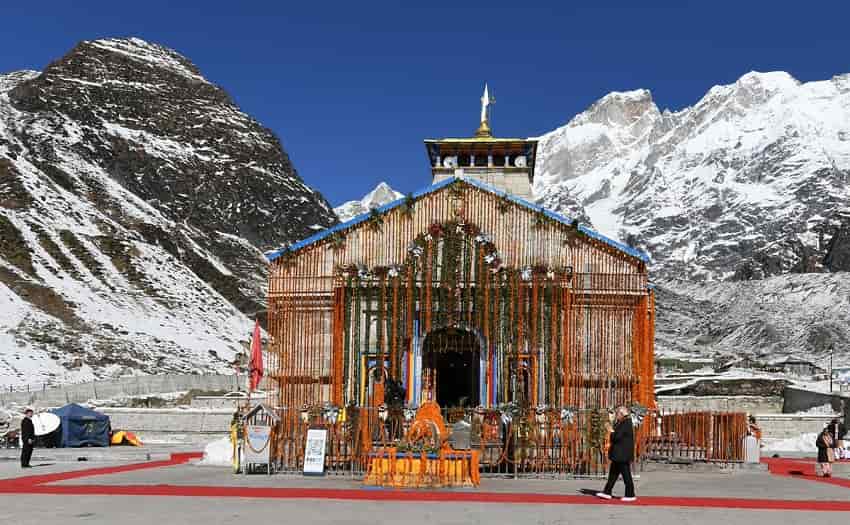Located at an elevation of 3583 meters above sea level, Kedarnath is believed to be one of the most sacred pilgrimage destinations of Lord Shiva. The pilgrimage is located near to the Chorabari glacier in Uttarakhand and on the divine Alaknanda riverbank. Kedarnath Temple is counted amongst one of the 12 Jyotirlingas in India which holds a high religious significance mentioned in the holy epic of Mahabharata. Kedarnath is considered as one of the most sacred pilgrimages amongst the Chota Char Dham pilgrimage circuit situated in the northern Himalayas of Uttarakhand. There are dense forests and snow-covered mountains surrounding the temple. The pilgrimage doesn’t only hold a high significance in Hinduism but also it holds some mythologies and facts associated with it. There are myriads of facts associated with the temple which make it a not to miss pilgrimage. Chardham Tour Package plays a vital role in visiting this holy place of Lord Shiva and in getting practical experience. Let’s have a look at some of the amazing facts about Kedarnath:

Fact 1: Creation of Kedarnath
As per Hindu Legend which states that Nar and Narayan (the two incarnations of Lord Vishnu) performed a deep atonement in Badrikashraya of Bharat Khanda. They paid their homage at a Shivlingam which had naturally emerged out on the earth beautifully. This made Lord Shiva pleased with Nar and Narayan and he offered them to ask a reward. The two incarnations of Lord Vishnu requested Lord Shiva to reside permanently at Kedarnath and this is how Kedarnath had originated.
Fact 2: Legends behind the creation of Kedarnath
The origin of Kedarnath is associated with the era of Mahabharata. The legend states that Pandavas were burdened with the guilt of killing fratricide and performed atonement to please Lord Shiva. Lord Shiva doesn’t want to forgive them easily and so transformed himself into a bull and hid at Kashi which was then called as GuptKashi. Eventually, Pandavas managed to find Lord Shiva underneath the ground. This made Lord Shiva impressed and he absolved their sins of killing their cousins.
Fact 3: How did the place get its name?
One of the most interesting facts about Kedarnath is the derivation of its name. According to an ancient tale, the gods worshipped Lord Shiva to protect themselves from the ferocious demons. Lord Shiva appeared and transformed himself into a bull and then said to the Kodarum (whom to rip and whom to tear apart). Lord Shiva destroyed the demons with his hooves and horns and threw them into the Mandakini River. This is how the place got its name Kedarnath derived from the word Kodarum.
Fact 4: Kedarnath Conservation
Very fewer people know that the Bhairav Nath Ji Temple which is located nearby the Kedarnath Temple acts as a guardian of Kedarnath and protects it from any mishappening or tragedy. It is a thought in Hinduism that when the temple remains closed during the winter season, Sri Bhairavnath Ji protects the temple during that time. Hence, at the opening and closing of the temple, Bhairavnath Ji Temple is heavily crowded with devotees paying their offerings and seeking blessings from the deity.
Fact 5: Importance of Kedarnath Jyotirlingam
Kedarnath is a highly revered lingam amongst the 12 divine Jyotirlingams of Lord Shiva in India. it is believed that the shrine blesses the Himalayas with serenity and spirituality and keeps them always dipped in the godliness of Lord Shiva. Hindu mythologies state Kedarnath as a place where devotees can seek salvation.
Fact 6: The holy shrine of Kedarnath
The temple is believed to be around 1000 years old and has been blessing the tourists and devotees visiting and praying to Lord Shiva even the Himalayas surrounding the temple have also been blessed. it is said that in the devastating flood of 2013, everything was ruined completely in Kedarnath except the holy shrine of Lord Shiva. The huge rock which is located behind the temple diverted the direction of the destructive flood which was moving towards the shrine.
Fact 7: Premise of the Kedarnath Temple
It is believed that the main priests of the Kedarnath Shrine belong to the Veerashaiva community of the southern state of India (Karnataka) and are also known as Raval. However, there are other priests who perform the pooja ceremonies inside the temple but the Pooja is done under the assistance and instructions of Raval. During the winter season, Raval also moves to Ukhimath along with the deity of Kedarnath Temple.
Fact 8: A persuading place of Pandavas
According to Hindu mythology, Pandavas were heavily burdened with the guilt of killing their cousins. In order to seek salvation and absolve their sins, they performed deep penance in front of Lord Shiva to please him. Lord Shiva didn’t want to grant them forgiveness and disguised himself as a bull and hid in the Himalayas with other animals. However, one of the Pandava brothers named Bheema recognized him and tried to follow him but Lord Shiva submerged himself under the ground. Bheema got the hold of his hump and since then Lord Shiva has been worshipping as a bull’s hump at Kedarnath.
Days had gone a long back when you had to cover the long-distance pilgrimage on your barefoot. Now, there are many companies providing numerous packages for Kedarnath yatra by helicopter.

 Call
Call WhatsApp
WhatsApp Enquiry
Enquiry